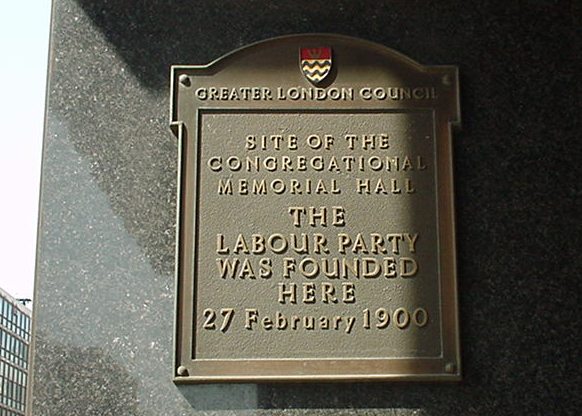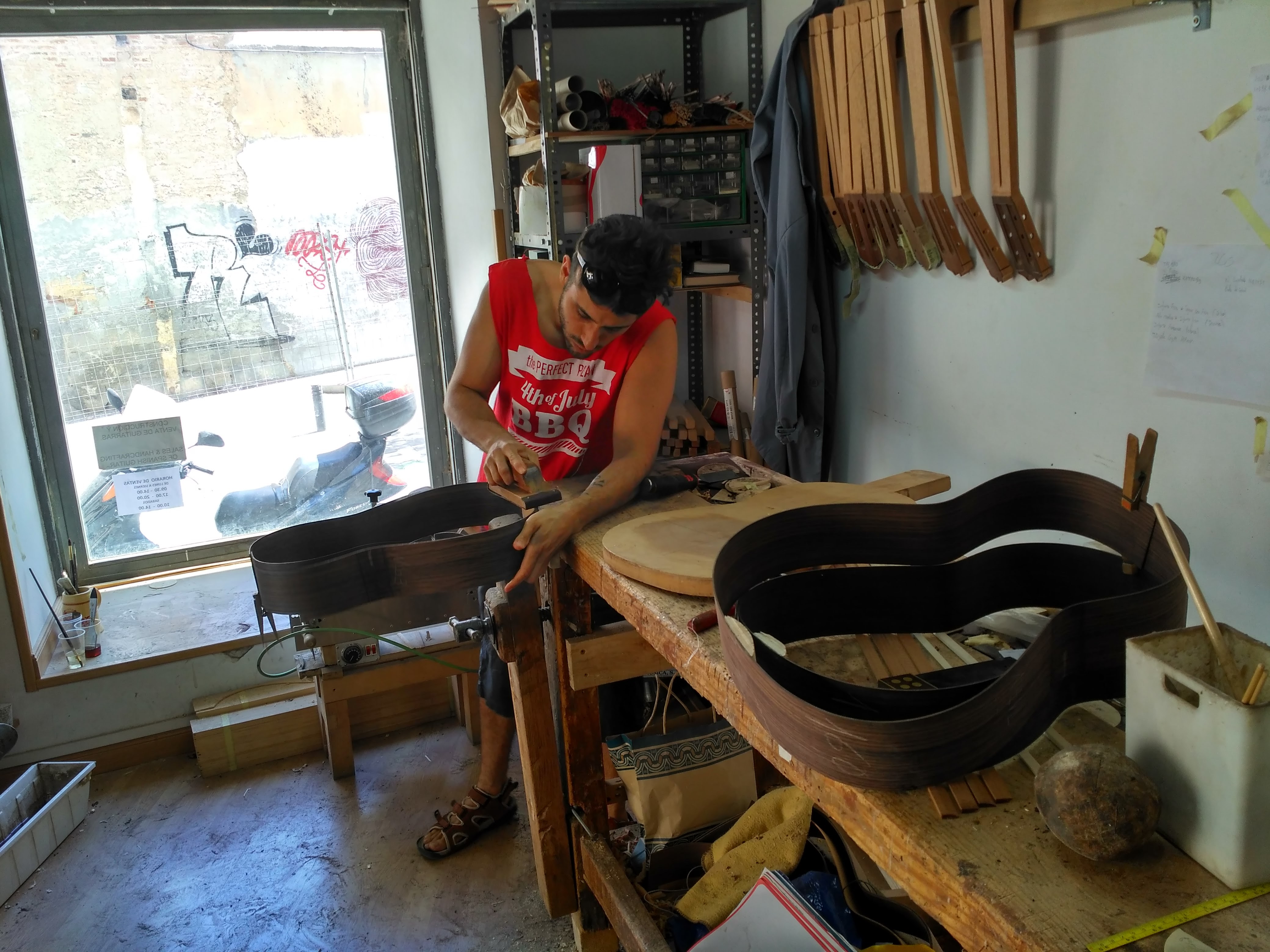|
Émile Auguste Ouchard
Émile Auguste Ouchard (24 July 1900–14 February 1969) was a French bow maker of repute and son and pupil of Émile François Ouchard. Honors & awards include the Grand Prix of the 1942 International Paris Exhibition. Biography He was born in 1900 in Mirecourt (Vosges). After his apprenticeship E.A. Ouchard worked for a few years with his father at rue Canon in Mirecourt. Later worked in Paris and the United States, returning to France in the mid 1950s. To be more exact, in 1940 A. Ouchard started his own workshop at rue de Rome in Paris before leaving for the United States in 1946. He first joined RUDIE in New York and then LEWIS & Sons in Chicago. His bows are similar to those of the Voirin-Lamy school. A master craftsman and artist who made bows with perfect symmetry and with the perfect balance of suppleness and resistance for effortless staccato and cantabile sound. He died in Gan in 1969. Collaborators & successors include Bernard Ouchard (b. 1925) (son) and Jean ... [...More Info...] [...Related Items...] OR: [Wikipedia] [Google] [Baidu] |
Émile François Ouchard
Émile François Ouchard (30 April 1872–27 February 1951) was a bow maker (''archetier'') for stringed instruments from Mirecourt, Vosges, France. Ouchard was also known as "Ouchard Père". Biography Émile François Ouchard began his apprenticeship in 1886 at the workshop of Eugène Cuniot-Hury in Mirecourt. Following the death of Cuniot-Hury in 1910, Ouchard stayed with Cuniot's widow to assist her in the running of the workshop, and so came to inherit the Cuniot-Hury business. In 1923, he opened his own workshop at 1, rue Canon in Mirecourt. By then Émile Ouchard had become a prolific bow maker, and prior to opening his own workshop had worked for Joseph Aubry, Paul Bisch & Olivier, Georges ConĂ©, Charles Enel, Jean Lavest and Cuniot-Hury Émile François Ouchard died in his hometown of Mirecourt in 1951. Emile Ouchard used only one stamp during his career: « Emile Ouchard ». He was succeeded by his son and pupil, Émile Auguste Ouchard Émile Auguste Ouchard (2 ... [...More Info...] [...Related Items...] OR: [Wikipedia] [Google] [Baidu] |
Mirecourt
Mirecourt () is a Communes of France, commune in the Vosges (French department), Vosges Departments of France, department in Grand Est in northeastern France. Mirecourt is known for lace-making and the manufacture of musical instruments, particularly those of the violin family. Geography Mirecourt is the administrative capital of a Canton of Mirecourt, canton positioned in the Xantois district at the heart of the Vosges plain, at the confluence of the Madon, River Madon with the Arol Valley. Most of the town is laid out on the west side of the Madon on a succession of levels. Visitors are attracted by the richness of the town's architecture and by the natural advantages of the site. Mirecourt is also at the heart of a road crossing, from Vittel, from Épinal to the east by southeast, from Neufchâteau, Vosges, Neufchâteau and from Nancy, France, Nancy. For much of the twentieth century Mirecourt was a staging post on the :fr:Route nationale 66, RN66, a major road towards Pari ... [...More Info...] [...Related Items...] OR: [Wikipedia] [Google] [Baidu] |
Vosges
The Vosges ( , ; ; Franconian and ) is a range of medium mountains in Eastern France, near its border with Germany. Together with the Palatine Forest to the north on the German side of the border, they form a single geomorphological unit and low mountain range of around in area. It runs in a north-northeast direction from the Burgundian Gate (the Belfort– Ronchamp– Lure line) to the Börrstadt Basin (the Winnweiler– Börrstadt– Göllheim line), and forms the western boundary of the Upper Rhine Plain. The Grand Ballon is the highest peak at , followed by the Storkenkopf (), and the Hohneck ().IGN maps available oGéoportail/ref> Geography Geographically, the Vosges Mountains are wholly in France, far above the Col de Saverne separating them from the Palatinate Forest in Germany. The latter area logically continues the same Vosges geologic structure but traditionally receives this different name for historical and political reasons. From 1871 to 1918 the Vos ... [...More Info...] [...Related Items...] OR: [Wikipedia] [Google] [Baidu] |
Bernard Ouchard
Bernard Ouchard (15 February 1925, in Mirecourt – 2 June 1979, in Vittel) was a French master bow maker and teacher in the School of Violin and Bowmaking of Mirecourt, France. He is considered by some to have been the last historical French master bow maker. Bernard Ouchard was the son of Émile Auguste Ouchard and the grandson of Émile François Ouchard, both famous bowmakers. He learned his craft from his father and later worked for Vidoudez (a violinmaker of international repute) in Geneva. He was asked to return to France and give a new impetus to the revival of the French tradition(s) of bow making. He became the master bowmaker and teacher in the School of Violin and Bowmaking of Mirecourt, France. "Bernard, (b. 1925) son of E. A. Ouchard, became his pupil, and worked with Vidoudez in Geneva before being appointed professor of bow making at the Mirecourt school in 1971, giving rise to the New French School which has produced such luminaries as Benoît Rolland, Jean-Yves ... [...More Info...] [...Related Items...] OR: [Wikipedia] [Google] [Baidu] |
Geneva
Geneva ( , ; ) ; ; . is the List of cities in Switzerland, second-most populous city in Switzerland and the most populous in French-speaking Romandy. Situated in the southwest of the country, where the RhĂ´ne exits Lake Geneva, it is the capital of the Canton of Geneva, Republic and Canton of Geneva, and a centre for international diplomacy. Geneva hosts the highest number of International organization, international organizations in the world, and has been referred to as the world's most compact metropolis and the "Peace Capital". Geneva is a global city, an international financial centre, and a worldwide centre for diplomacy hosting the highest number of international organizations in the world, including the headquarters of many agencies of the United Nations and the International Committee of the Red Cross, ICRC and International Federation of Red Cross and Red Crescent Societies, IFRC of the International Red Cross and Red Crescent Movement, Red Cross. In the aftermath ... [...More Info...] [...Related Items...] OR: [Wikipedia] [Google] [Baidu] |
Benoît Rolland
Benoît Marie Rolland (born 12 September 1954 Paris), is a bow maker and musician, currently established in Boston, Massachusetts. An internationally renowned bow maker, he is a 2012 MacArthur Fellow and a Chevalier des Arts et des Lettres (2017). Biography Early years Rolland was born into a Parisian family of old descent. He received his early musical training at the age of four from his grandmother Germaine Thyssens-Valentin, a renowned concert pianist. During his childhood he frequented her musical salon, where composers such as Olivier Messiaen and other performers gathered. He began to play the violin at age eight and subsequently entered the Versailles conservatory and the Conservatoire de Paris, graduating at age 16. Among his professors were Alfred Loewenguth and Line Talluel. Aside from violin performance, his perfect pitch led to advancement in his ability to read and write music. He honed his skill for musical composition at the Schola Cantorum de Paris (1980–82) ... [...More Info...] [...Related Items...] OR: [Wikipedia] [Google] [Baidu] |
Universal Dictionary Of Violin & Bow Makers
The ''Universal Dictionary of Violin & Bow Makers'' is a widely cited reference work providing information on approximately 9,000 violin makers. The work is based on the extensive notes of violinist and composer William Henley (1874-1957). Henley had in his youth studied with August Wilhelmj, and later became a professor of composition and principal of the violin at the Royal Academy in London. Having played violins from many manufacturers, Henley sought to compile a comprehensive list evaluating violin and bow makers. After Henley's death in 1957, dealer Cyril Woodcock (1897–1980) completed and published the work based on Henley's unfinished notes. The work was first published in five volumes in 1959 and 1960, and republished in a single volume in 1973. Background The book was the first to include a significant number of American craftsmen. Henley traveled extensively as a performer, primarily with his quartet. It was during his trips, including a supposed trip to America dur ... [...More Info...] [...Related Items...] OR: [Wikipedia] [Google] [Baidu] |
William Henley (violinist)
William Henley (1874–1957) was an English violinist, arranger of music, music teacher, and composer. Biography William Henley was born at West Bromwich on January 28, 1874, and started playing the violin under his father John, at the age of six. After studying under him for five years, Henley studied with Mr. T. M. Abbott, of Birmingham. His first concert tour in 1886 was through Gloucestershire and the Forest of Dean, where he was announced as the "boy Paganini". In 1887 he became leader of the band that accompanied D'Oyly Carte's No. 1 Company to the principal towns of France. In October, 1888, he went on a tour through Lancashire with H. T. Bywater. When performing in Birmingham in 1889, he came into contact with Councillor Beale, who was a musical enthusiast and suggested Henley should go to London for violin lessons, and kindly provided him with the means to continue his musical studies there. After studying the violin for two years with Henry Holmes, during which time ... [...More Info...] [...Related Items...] OR: [Wikipedia] [Google] [Baidu] |
1900 Births
As of March 1 ( O.S. February 17), when the Julian calendar acknowledged a leap day and the Gregorian calendar did not, the Julian calendar fell one day further behind, bringing the difference to 13 days until February 28 ( O.S. February 15), 2100. Summary Political and military The year 1900 was the end of the 19th century and the beginning of the 20th century. Two days into the new year, the U.S. Secretary of State John Hay announced the Open Door Policy regarding China, advocating for equal access for all nations to the Chinese market. The Galveston hurricane would become the deadliest natural disaster in United States history, killing between 6,000 and 12,000 people, mostly in and near Galveston, Texas, as well as leaving 10,000 people homeless, destroying 7,000 buildings of all kinds in Galveston. As of 2025, it remains the fourth deadliest Atlantic hurricane on record. An ongoing Boxer Rebellion in China escalates with multiple attacks by the Boxers on Chines ... [...More Info...] [...Related Items...] OR: [Wikipedia] [Google] [Baidu] |
1969 Deaths
1969 (Roman numerals, MCMLXIX) was a common year starting on Wednesday of the Gregorian calendar, the 1969th year of the Common Era (CE) and ''Anno Domini'' (AD) designations, the 969th year of the 2nd millennium, the 69th year of the 20th century, and the 10th and last year of the 1960s decade. Events January * January 4 – The Government of Spain hands over Ifni to Morocco. * January 5 – Ariana Afghan Airlines Flight 701 crashes into a house on its approach to London's Gatwick Airport, killing 50 of the 62 people on board and two of the home's occupants. * January 14 – USS Enterprise fire, An explosion aboard the aircraft carrier USS Enterprise (CVN-65), USS ''Enterprise'' near Hawaii kills 28 and injures 314. * January 16 – First successful docking of two crewed spacecraft in orbit and the first transfer of crew from one space vehicle to another (by a space walk) between Soviet craft Soyuz 5 and Soyuz 4. * January 18 – Failure of Soyuz 5's service module to separ ... [...More Info...] [...Related Items...] OR: [Wikipedia] [Google] [Baidu] |
Luthiers From Mirecourt
A luthier ( ; ) is a craftsperson who builds or repairs string instruments. Etymology The word ' is originally French and comes from ''luth'', the French word for "lute". The term was originally used for makers of lutes, but it came to be used in French for makers of most bowed and plucked stringed instruments such as members of the violin family (including violas, cellos, and double basses) and guitars. Luthiers, however, do not make harps or pianos; these require different skills and construction methods because their strings are secured to a frame. Craft The craft of luthiers, lutherie (rarely called "luthiery", but this often refers to stringed instruments other than those in the violin family), is commonly divided into the two main categories of makers of stringed instruments that are plucked or strummed and makers of stringed instruments that are bowed. Since bowed instruments require a bow, the second category includes a subtype known as a bow maker or archetier. L ... [...More Info...] [...Related Items...] OR: [Wikipedia] [Google] [Baidu] |




